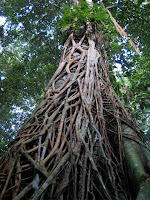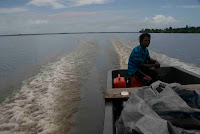
One may wonder how I get to post these blog entries from such a remote country as the Solomons Islands? Well, what a wonderful way to win your own carbon credits by going to the internet by kayak!!
The European Union has funded a small number of internet base stations throughout the country. These are called distance learning centers. These satellite links are completely independent from the unreliable Solomon island Telekom company. They employ their own IT technicians. One such school at BekaBeka is located 5 miles away from the Peava anchorage so an easy day trip with a purpose, 45 minutes each way on a good day. The hard bit is to paddle back into a 35 knots squall wind

Along with the Distance Learning Centers, which have internet connections, some good education initiatives are being carried out in the area. Morovo lagoon is the test area for a new education initiative called OLPC: One Laptop per Child. 100$ labtop conceived for developing countries, making computing and internet accessible as a learning tool. Despite being small and looking like a toy, the Linux based OLPC labtop has all the wireless connectivity from standard labtops – and more - and is rugged for the wet and dusty environment. Really, I’d like one for the boat!!!!! The children are absorbing computer technology rapidly and teach eachother and many more teaching materials are accessed through the labtop, as it is a lot easier and cheaper to move files than books in this country.

The satellite based internet link for Morovo needs continued support from the EU. Having more and more users is the best way to justify applying for continued technical support and funding. Along with the spread of DVD technology in the villages, internet and computer are viable ways to convey important conservation principles amongst younger generations and help the inhabitants of Morovo lagoon manage their resources sustainably. There is a long way to go but many dynamic players keep chipping at it. For example, the conservation DVD project involving the KUNA has good hope to receive enough interest and raise funding.





































